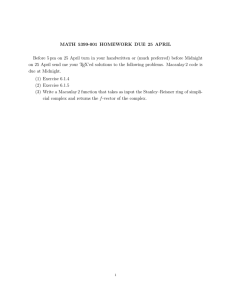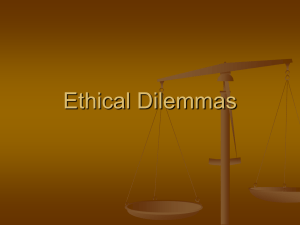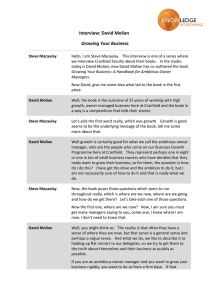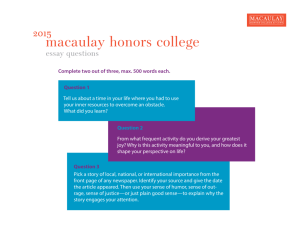CRM: Making it work Stan Maklan
advertisement
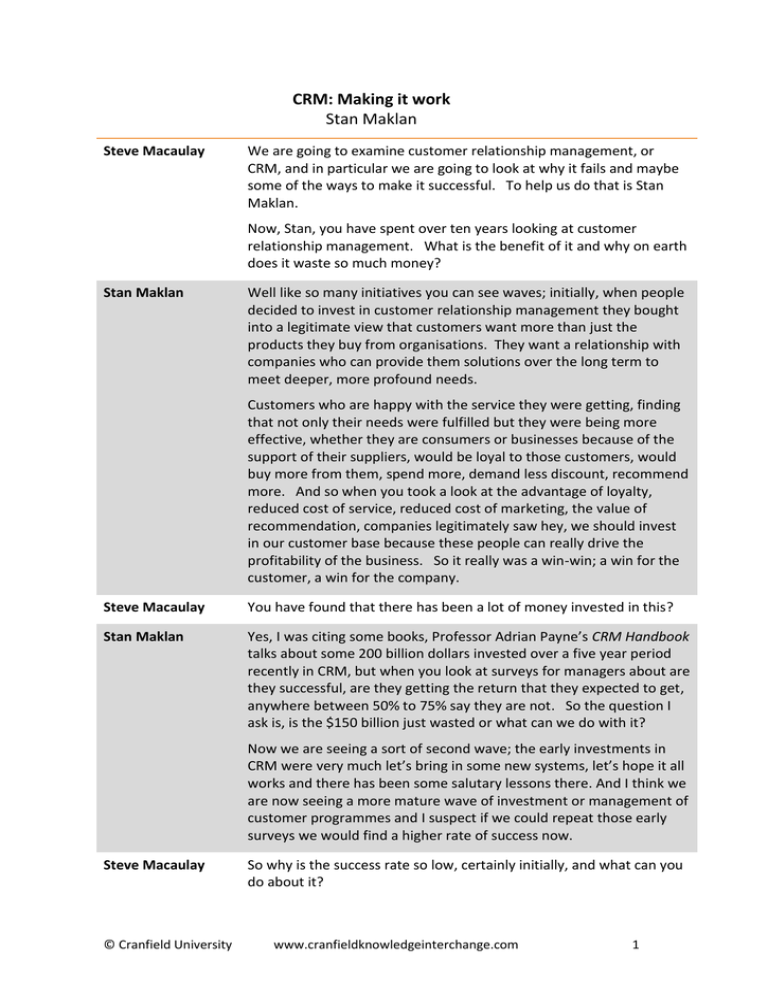
CRM: Making it work Stan Maklan Steve Macaulay We are going to examine customer relationship management, or CRM, and in particular we are going to look at why it fails and maybe some of the ways to make it successful. To help us do that is Stan Maklan. Now, Stan, you have spent over ten years looking at customer relationship management. What is the benefit of it and why on earth does it waste so much money? Stan Maklan Well like so many initiatives you can see waves; initially, when people decided to invest in customer relationship management they bought into a legitimate view that customers want more than just the products they buy from organisations. They want a relationship with companies who can provide them solutions over the long term to meet deeper, more profound needs. Customers who are happy with the service they were getting, finding that not only their needs were fulfilled but they were being more effective, whether they are consumers or businesses because of the support of their suppliers, would be loyal to those customers, would buy more from them, spend more, demand less discount, recommend more. And so when you took a look at the advantage of loyalty, reduced cost of service, reduced cost of marketing, the value of recommendation, companies legitimately saw hey, we should invest in our customer base because these people can really drive the profitability of the business. So it really was a win-win; a win for the customer, a win for the company. Steve Macaulay You have found that there has been a lot of money invested in this? Stan Maklan Yes, I was citing some books, Professor Adrian Payne’s CRM Handbook talks about some 200 billion dollars invested over a five year period recently in CRM, but when you look at surveys for managers about are they successful, are they getting the return that they expected to get, anywhere between 50% to 75% say they are not. So the question I ask is, is the $150 billion just wasted or what can we do with it? Now we are seeing a sort of second wave; the early investments in CRM were very much let’s bring in some new systems, let’s hope it all works and there has been some salutary lessons there. And I think we are now seeing a more mature wave of investment or management of customer programmes and I suspect if we could repeat those early surveys we would find a higher rate of success now. Steve Macaulay © Cranfield University So why is the success rate so low, certainly initially, and what can you do about it? www.cranfieldknowledgeinterchange.com 1 Stan Maklan Stan Maklan I think the success rate was low because I think firms had a technology based view of it, because there is a technology component to the database – the mining tools, the sales force automation – the rest of it was complex. What you found was that the marketers had some vague idea, yes, let’s get closer to our customers but couldn’t operationalize that into systems and structures. It is not the way marketing people are trained. Those with that capability in the organisation were the technologists, the IT people, but of course they weren’t trained or capable in the management of relationships – how trust forms, how you build that sort of trust. So you fell into a bit of black hole here; you thought that the IT department could specify a system, the marketing people couldn’t really tell you what they were going to do with it until they played with the system and so you fell into this little gap between those who understood the customer and those who understood the technology. Steve Macaulay You have got some quite clear views about the antidote to this, haven’t you? Stan Maklan Well, yes. What my research has shown is that the companies that succeed are not the ones who start off with big investments in technology first and hope the capabilities to manage customers will follow; quite the opposite. They are almost acting like venture capitalists; they are saying let’s do a little, let’s ring fence some customers, let’s get the relationship right, let’s see what the benefits are, let’s develop a team of people who know what they are doing. Let’s create the business case from real situations, see what it is like and then backfill with further technology investments to make it better and to scale it up across the business. Steve Macaulay So bit by bit, steady as she goes, build the capability? Stan Maklan Definitely, I think people should be learning and capability focused when investing in marketing type technologies; not asset focused. The idea that you can spend a lot of money on a system, train people in the technical aspects of the system and then their capabilities to extract value from it will automatically comply, I think is false. I would do it the other way round. And that way you invest a bit of money, you have a team that knows what they are doing and they can specify exactly the investments they need. You really de-risk your investment in that way; it is almost like buying a real option on your customer management. Steve Macaulay So if you were to pick a small number of those capabilities, what would they be? Stan Maklan Part of the challenge of CRM is it is very context specific. What works for a car company where people buy their car every three or © Cranfield University www.cranfieldknowledgeinterchange.com 2 Stan Maklan four years is far different, for example, than an online betting company where people could be on the site several times a day. What works for a company like Tesco will be different from a company like Dell or Apple because of the nature of the product, the involvement, the purchase cycle. So there is unfortunately no generic rule. I think the first thing you have to do is to see to what extent the customer does respond to the initiatives, what value is really created to the customer with your CRM programme – not just value to you, is there value to the customer? How to make it operational? What things does the customer react to, what do they appreciate, what don’t they appreciate? How much they are willing to invest in the relationship? Who in the organisation is capable of changing the relationship, in managing it? Do you have the skills in place? Do you have the right people? Do you have the right channels? So I think you have got to answer all those questions; so the answer is a combination of channel, of skills, of customer, of proposition and there is no one size fits all, which is why I say the experimental and learning approach is more likely to succeed. Steve Macaulay So a key message on how to respond to the challenges of CRM? Stan Maklan I guess if there is one piece of advice I would make to companies, it would be to move away from the idea of a top down, directed, single hit investment approach to CRM and replace that with much more of a bottom up, leadership from the middle managers who have to make it work with customers and let them drive the pace of the programme, the pace of investment. Steve Macaulay Stan, thank you very much. © Cranfield University www.cranfieldknowledgeinterchange.com 3

